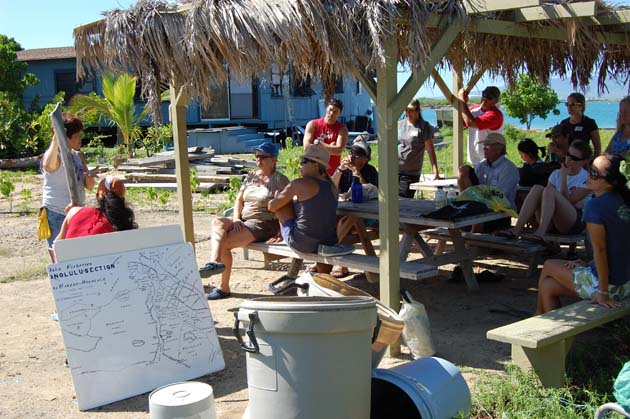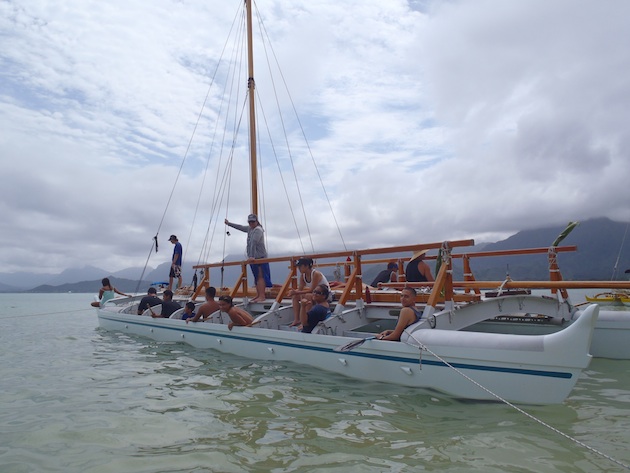Classroom Curriculum and Activities
Curriculum for the 2012 Statewide Sail and the 2013-2017 Worldwide Voyage
The Education Hui of the Polynesian Voyaging Society is developing curriculum to share with teachers during the statewide sail and Worldwide Voyage of Hōkūle‘a.
Lesson Plans: Science and Math
Native Hawaiian Plants (htm file) (Grade 9-12), developed by Matt Kanemoto, Kahuku High School. Ten lessons focused on learning about native plants, with hands on applications for propagating, potting, and caring for plants, and planting a Native Hawaiian Garden.
Coral Reef Ecology (Grades 4-8, length: 60 minutes), developed by Karen Holman for the Bishop Museum’s Holoholo Science program: Explore the underwater world as you act as a marine biologist to assess the health of Hawai‘i’s coral reefs. In a comparison of Northwestern and Main Hawaiian Island coral reef ecosystems, students use the scientific method to identify threats facing coral reefs and determine how, why, and where they occur. Students also identify different types of coral, handle real specimens, and observe coral structure up-close under microscopes.
Does Conservation Work? (Grade 9 - 12; Project Time Span: 2 weeks; htm file), developed by Margaret Pulver Ho‘āla School. Students are familiarized with the scientific process and how it relates to modern actions in environmental management and conservation.

Teachers learning about Mokauea Island in Honolulu Harbor.
Ethnomathematics Calculus Summer Institute (UH students who have passed Math 103 or equivalent, high school math teachers, and college math faculty; May 25, 2011 – June 5, 2011, 8:30-12:30 p.m., including weekends; Developer and Coordinator: Linda Furuto): Students and educators in the Ethnomathematics Calculus Summer Institute will be engaged in calculus-related topics including, but not limited to, the following: vector operations, tangent lines, limits, continuity, derivatives, antiderivatives, integration and basic applications, and more. In addition, field studies grounded in ethnomathematics will be planned for the participants to Mokauea Island Fishing Village, Hawai‘i Institute of Marine Biology’s Coconut Island in Kane`ohe Bay, hiking down to Kalaupapa on Moloka‘i, and sailing on Noa Noa with the Polynesian Voyaging Society. Examples of potential curriculum design and lesson plans include navigation calculations with geometric properties, caring for each other and number foundations in the environment, natural resources and algorithms, reawakening pride in fishing traditions and algebra, and linear equations in the highest sea cliffs in the world at Kalaupapa.
Sust‘ĀINAbility Around the World (htm files) (Secondary/Post Secondary students). Developed by for Curriculum Studies/EDCS 630-Cultural Diversity & Education, University of Hawai‘i at Mānoa, Spring 2011. The curriculum plan addresses the different facets of sustainability around the world, with an emphasis on building global relationships. The curriculum is intended for informal education, but units and lessons may be applied in classrooms, especially here in Hawai'i. This curriculum can be applied to an audience of stakeholders from around the world who are at the secondary level and higher (adults) from a variety of ethnicities, communities, and educational levels, and backgrounds. The goal is to help participating stakeholders understand the role of sustainability in developing and nurturing global relationships.
- Sust‘ĀINAbility Around the World, by Cathy Ikeda, Heipua Kaopua, Jessica Ayau, and Kalei Lum-Ho
- Culture and Literature, by Cathy Ikeda
- Sustainability and Environment, by Jessica Ayau
- Politics and Language Sustainability, by Kalei Lum-Ho
Lesson Plans: Multidisciplinary
Ka Waka o Ka Manō (pdf file) (Grade 9-10), developed by Hālau Kū Māna, New Century Public Charter School, and used for its five-day voyaging camp at Kualoa Regional Park, O‘ahu, May 2011. Multidisciplinary curriculum, covering standards in Language Arts, Social Studies, Math, and Science.

Students sailing on Kamauheheu, Honolulu Community College's coastal sailing canoe. Hakipu‘u 2011.
Incorporating a Voyaging Curriculum into Mainstream Curriculum. (6th grade; two semesters). Developed by Leimomi, Kekina Dierks. Voyaging makes a perfect ethnoscience course. During the course of a 2 semester program, I usually teach the physical sciences (astronomy, oceanography, meteorology, geology) in the fall semester, and the biological sciences (marine biology and ethnobotany) in the spring semester, all from a cultural perspective while blending modern techniques and technology.
Ideas for Hōkūle‘a-Related Lessons (3rd grade; Varied Time Spans). Developed by Malia Ane, Punahou School. Technology use is integrated into the lessons. Lessons, with sample student work, include the following: (1) Hawaiian plants (pdf file). (2) Stories of the land (pdf file). (3) Poetry and Reflections (pdf file). (4) Let the Steering Paddle Speak pdf file). (5) More Poetry (pdf file). (6) Looking at the Starry Sky (pdf file). (7) Locating Islands on Maps (Google Earth) (pdf file).
Voyaging Camp for Boy Scouts. Developed by Mark Ellis.
E Ho‘i Mau: Honoring the Past Caring for the Present, Journeying to the Future. (htm file) (Elementary school students) Developed by Sara Seman, Anna Lum, and Stephanie Hurder, for Curriculum Studies/EDCS 630- Cultural Diversity & Education, University of Hawai‘i at Mānoa, , Spring 2011. This curriculum plan was designed to teach young children about caring. Caring for themselves in the choices they make, their friends and family, the community they come from and ultimately the world in which we all live. The curriculum is divided into three sections:
- Lesson 1-2: Mālama Ourselves
- Lesson 3-7: Mālama Our Community
- Lesson 8-12: Mālama Our World
Lesson Plans: College Composition
Mālama Hawai'i, Mālama Honua: A Vision-Based Writing Sequence for College Writing (Freshman English, length: 1 semester. The sequence of writing assignments, based in the vision of Mālama Hawai‘i and the voyaging process, is being designed by Dennis Kawaharada for two 3-credit accelearted writing courses (Eng 22 and Eng 100) at Kapi‘olani Community College. The writing sequence will be piloted in fall 2011, as part of an interdisciplinary cluster of courses that include Hawaiian language, ethnobotany, and anthropology.
Model Curriculum Projects
The following sites and resources offer examples and models for curriculum development in cultural and environmental studies related to voyaging and thePVS vision of Mālama Hawai‘i, Mālama Honua (“Taking Care of Hawai‘i/Taking Care of the Earth”).

Mālama Honua (”Taking care of the earth”)
Kūlia i ka Nu‘u: This project is dedicated to preparing teachers to be knowledgeable in strategies that support Native Hawaiian students' success in science and related STEM fields where they are underrepresented. It intends to achieve this goal by providing teachers with (1) place and culture-based knowledge and skills leading to teacher developed curriculum products, (2) opportunities to participate in authentic science learning communities, and (3) co-instruction by Site Teachers with exemplary sites and programs. The project is housed in the Curriculum Studies Department, University of Hawai‘i at Mānoa's College of Education, offering professional development for teachers through two courses: EDCS 433 Interdisciplinary Science Curriculum, Mālama I Ka ‘Āina, Sustainability, and EDCS 450 Materials and Methods. For sample lessons, by grade level, see "pīkoi ke kaula kualena." Contact: Dr. Pauline Chinn.
PRISM Curricula: The Partnerships for Reform through Investigative Science and Mathematics (PRISM) GK-12 Program is a unique partnership between the Hawaii Island Department of Education (HIDOE) and the University of Hawaii at Hilo (UHH). This collaboration will bring together the science-content knowledge of faculty and graduate students (PRISM fellows) of the UHH Tropical Conservation Biology and Environmental Sciences (TCBES) Masters Program with the teaching skills of lead teachers in K-8 schools on the island of Hawaii. The program is funded by a National Science Foundation grant.
A central goal of PRISM is to improve the interest and performance of Hawaii K-8 students in math and science. This goal is addressed through the creation of investigative, standards-based curricula in science, math, and technology that are both relevant and accessible to Hawaii’s rural student population.
Mālama Mo‘olelo (“Taking care of stories and traditions”)
Pacific World: an Indigenous Geography Education Tool for Pacific Islands: Developed as a Teacher’s Resource Guide to engage students in geographical thinking about the Pacific Islands by drawing on their own cultural resources and home-island locations. At the same time, these exercises often require comparative consideration of "Western" versus indigenous views. These resources are currently aimed at the 4th grade to 8th grade level, but can be used with other age groups. They have even been used at the university level. Each presentation is set up as a virtual voyage/journey of discovery with eight chapters: Arrival, A Native Place, The Sea, The Land, Footprints, Visitors, Memories, Onwards.
Among the places in Hawai'i that have their stories told at the site are the following:
Pacific Worlds is organized by RDK (Doug) Herman, Department of Geography, Towson University, with assistance from various sponsors and supporters.
For another project on local history and geography, see Maunalua, O‘ahu, by Maunalua.net with support from Aloha Aina o Kamilonui, Livable Hawaii Kai Hui & The Maunalua Fishpond Heritage Center.
Mālama Kekahi i Kekahi (“Taking care of each other”)
Mālama i nā Ahupua‘a: A service learning program organized by the College of Social Sciences at the University of Hawai‘i at Mānoa for college students and their family and friends to develop a “sense of place” by creating a fund of knowledge and practical experience. It integrates cultural, historic and environmental learning and helps with restoration, maintenance, documentation, and oral history collection. The program works with a number of community partners and sites.
The Kapi‘olani Community College service learning program works in partnership with UHM’s Mālama i nā Ahupua‘a program. The KCC program offers students service learning opportunities in seven pathways:
- Arts, History, and Culture
- Bridging Generations
- Education
- Health
- Human and Social Services
- Environment
- International Perspectives
Curriculum Archive
2008-2009: Mālama Kaho‘olawe: Voyaging (Grade 8), developed by the Pacific American Foundation. This unit focuses on the island of Kaho‘olawe as a training site for ancient navigators.he island's position in relationship to the rest of the Hawaiian archipelago allowed navigators to study the stars, the sunrise/sunset, the winds and ocean currents. The island is the piko (center) of the Hawaiian island chain and "the point of arrival and departure for canoes journeying to and from the southern islands" (Reeve, 1995).
2004: Lesson Plans related to Voyaging created at a Kamehameha Schools Teacher Workshop (various grade levels and subject areas). The lesson plans are at the Polynesian Voyaging Society Kamehemeha School Archives.
2003-2004: The Teacher's Guide to "Navigating Change." A five-part, Hawai'i DOE Standards (HCPS 3) aligned curriculum for grades 4-5. This curriculum was developed as part of the 2003-2004 voyage to Papahānaumokuākea (Northwestern Hawaiian Islands).
1999-2000: Let’s Go Voyaging. Developed by Moanalua Gardens Foundation (MGF). Lessons for Grade 4 are online as pdf files at the MGF website. This curriculum was developed as part of the 1999-2000 voyage to Rapanui.
1999-2000: Exploring the Night Sky: How to Find Navigation Stars. Developed by PVS for the 1999-2000 voyage to Rapanui.
1996-1997: Statewide Voyage: Mālama Hawai‘i/Caring for Hawai‘i: Star Compass and Provisioning activities for schoolchildren visiting Hōkūle‘a during the Statewide Voyage.
1996: Reading the Wind, Navigation and the Environment in the Pacific / A Teacher's Guide (pdf file). Activities on observing the weather and finding navigation stars to accompany a video on Polynesian and Micronesian voyaging and migration. At the Pacific Region Eductional Laboratory (PREL) website.
1992: No Nā Mamo, A Voyage for Education / Classroom Activities: An interdisciplinary curriculum covering (1) Wayfinding and Polynesian Navigation; (2) Survival, Resources, and the Environment; (3) History of Exploration (Hōkūle‘a, Columbus, the Space Shuttle Columbia); (4) Hawaiian Canoe-Building Traditions; (5) Literature of Polynesian Seafaring; and (6) Voyaging as a Metaphor for Life. Developed by PVS for the 1992 Voyage to Rarotonga.
1986-1989: ‘Ohia Project: Science and Environmental Curriculum for grades K-3, 4-6, and 7-8. Developed by Moanalua Gardens Foundation. Popular out of print lessons are online at the MGF website.
1980: Polynesian Seafaring Heritage, edited by Cecilia Kapua Lindo and Nancy Alpert Mower. Honolulu: PVS and Kamehameha Schools. This 184-page anthology is a compendium on voyaging, with readings and suggestions for classroom activities. Avaiable at local libraries.
1975: Lesson Plan for Teaching about Hokule‘a. Hawai‘i State Department of Education (DOE). At the Polynesian Voyaging Society Archives/Kamehemeha School Archives.
